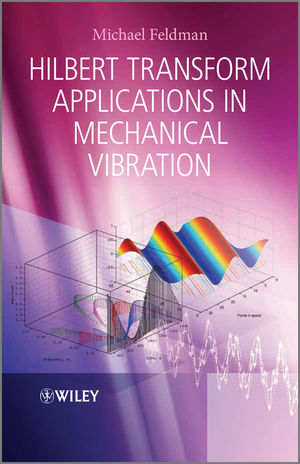Hilbert Transform Applications in Mechanical VibrationISBN: 978-0-470-97827-6
Hardcover
320 pages
March 2011
 This is a Print-on-Demand title. It will be printed specifically to fill your order. Please allow an additional 10-15 days delivery time. The book is not returnable.
|
||||||
List of Tables.
Preface.
1 INTRODUCTION.
1.1 Brief History of the Hilbert Transform.
1.2 Hilbert Transform in Vibration Analysis.
1.3 Organization of the Book.
PART I. HILBERT TRANSFORM AND ANALYTIC SIGNAL.
2 ANALYTIC SIGNAL REPRESENTATION.
2.1 Local Versus Global Estimations.
2.2 The Hilbert Transform Notation.
2.3 Main Properties of the Hilbert Transform.
2.4 The Hilbert Transform of Multiplication.
2.5 Analytic Signal Representation.
2.6 Polar Notation.
2.7 Angular Position and Speed.
2.8 Signal Waveform and Envelope.
2.9 Instantaneous Phase.
2.10 Instantaneous Frequency.
2.11 Envelope vs. Instantaneous Frequency Plot.
2.12 Distribution Functions of the Instantaneous Characteristics.
2.13 Signal Bandwidth.
2.14 Instantaneous Frequency Distribution and Negative Values.
2.15 Conclusions.
3 SIGNAL DEMODULATION.
3.1 Envelope and Instantaneous Frequency Extraction.
3.2 Hilbert Transform and Synchronous Detection.
3.3 Digital Hilbert Transformers.
3.4 Instantaneous Characteristics Distortions.
3.5 Conclusions.
Part II. HILBERT TRANSFORM AND VIBRATION SIGNALS.
4 TYPICAL EXAMPLES AND DESCRIPTION OF VIBRATION DATA.
4.1 Random Signal.
4.2 Decay Vibration Waveform.
4.3 Slow Linear Sweeping Frequency Signal.
4.4 Harmonic Frequency Modulation.
4.5 Harmonic Amplitude Modulation.
4.6 Product of Two Harmonics.
4.7 Single Harmonic with DC Offset.
4.8 Composition of Two Harmonics.
4.9 Derivative and Integral of the Analytic Signal.
4.10 Signal Level.
4.11 Frequency Contents.
4.12 Narrowband and Wideband Signal.
4.13 Conclusions.
5 ACTUAL SIGNAL CONTENTS.
5.1 Monocomponent Signal.
5.2 Multicomponent Signal.
5.3 Types of multicomponent signals.
5.4 Averaging Envelope and Instantaneous Frequency.
5.5 Smoothing and Approximation of the Instantaneous Frequency.
5.6 Congruent Envelope.
5.7 Congruent Instantaneous Frequency.
5.8 Conclusions.
6 LOCAL AND GLOBAL VIBRATION DECOMPOSITIONS.
6.1 Empirical Mode Decomposition.
6.2 Analytical Basics of the EMD.
6.3 Global Hilbert Vibration Decomposition.
6.4 Instantaneous Frequency of the Largest Energy Component.
6.5 Envelope of the Largest Energy Component.
6.6 Subtraction of the Synchronous Largest Component.
6.7 Hilbert Vibration Decomposition Scheme.
6.8 Examples of Hilbert Vibration Decomposition.
6.9 Comparison of the Hilbert Transform Decomposition Methods.
6.10 Common Properties of the Hilbert Transform Decompositions.
6.11 The Differences between the Hilbert Transform Decompositions.
6.12 Amplitude-Frequency Resolution of HT Decompositions.
6.13 Limiting Number of Valued Oscillating Components.
6.14 Decompositions of Typical Non-stationary Vibration Signals.
6.15 Main Results and Recommendations.
6.16 Conclusions.
7 SIGNAL ANALYSIS PRACTICE EXPERIENCE AND INDUSTRIAL APPLICATION.
7.1 Structural Health Monitoring.
7.2 Standing and Traveling Wave Separation.
7.3 Echo Signal Estimation.
7.4 Synchronization Description.
7.5 Fatigue Estimation.
7.6 Multichannel Vibration Generation.
7.7 Conclusions.
Part III. HILBERT TRANSFORM AND VIBRATION SYSTEMS
8 VIBRATION SYSTEM CHARACTERISTICS.
8.1 Kramers-Kronig Relations.
8.2 Detection of Nonlinearities in Frequency Domain.
8.3 Typical Nonlinear Elasticity Characteristics.
8.4 Phase Plane Representation of Elastic Nonlinearities in Vibration Systems.
8.5 Complex Plane Representation.
8.6 Approximate Primary Solution of a Conservative Nonlinear System.
8.7 Hilbert Transform and Hysteretic Damping.
8.8 Nonlinear Damping Characteristics in SDOF Vibration System.
8.9 Typical Nonlinear Damping in Vibration System.
8.10 Velocity-Dependent Nonlinear Damping.
8.11 Velocity-Independent Damping.
8.12 Combination of Different Damping Elements.
8.13 Conclusions.
9 IDENTIFICATION OF THE PRIMARY SOLUTION.
9.1 Theoretical Bases of the Hilbert Transform System Identification.
9.2 Free Vibration Modal Characteristics.
9.3 Forced Vibration Modal Characteristics.
9.4 BackBone (Skeleton Curve).
9.5 Damping Curve.
9.6 Frequency Response.
9.7 Force Static Characteristics.
9.8 Conclusions.
10 THE FREEVIB and FORCEVIB METHODS.
10.1 FREEVIB Identification Examples.
10.2 FORCEVIB Identification Examples.
10.3 System Identification with Biharmonic Excitation.
10.4 Identification of Nonlinear Time-Varying System.
10.5 Experimental Identification of Nonlinear Vibration System.
10.6 Conclusions.
11 CONSIDERING HIGH ORDER SUPERHARMONICS. IDENTIFICATION OF ASYMMETRIC AND MDOF SYSTEMS.
11.1 Description of the Precise Method Scheme.
11.2 Identification of the Instantaneous Modal Parameters.
11.3 Congruent Modal Parameters.
11.4 Congruent Nonlinear Elastic and Damping Forces.
11.5 Examples of Precise Free Vibration Identification.
11.6 Forced Vibration Identification Considering High-Order Superharmonics.
11.7 Identification of Asymmetric Nonlinear System.
11.8 Experimental Identification of a Crack.
11.9 Identification of MDOF Vibration System.
11.10 Identification of Weakly Nonlinear Coupled Oscillators.
11.11 Conclusions.
12 SYSTEM ANALYSIS PRACTICE EXPERIENCE AND INDUSTRIAL APPLICATION.
12.1 Non-parametric Identification of Nonlinear Mechanical Vibration Systems.
12.2 Parametric Identification of Nonlinear Mechanical Vibrating Systems.
12.3 Structural Health Monitoring and Damage Detection.
12.4 Conclusions.
References.
Index.



